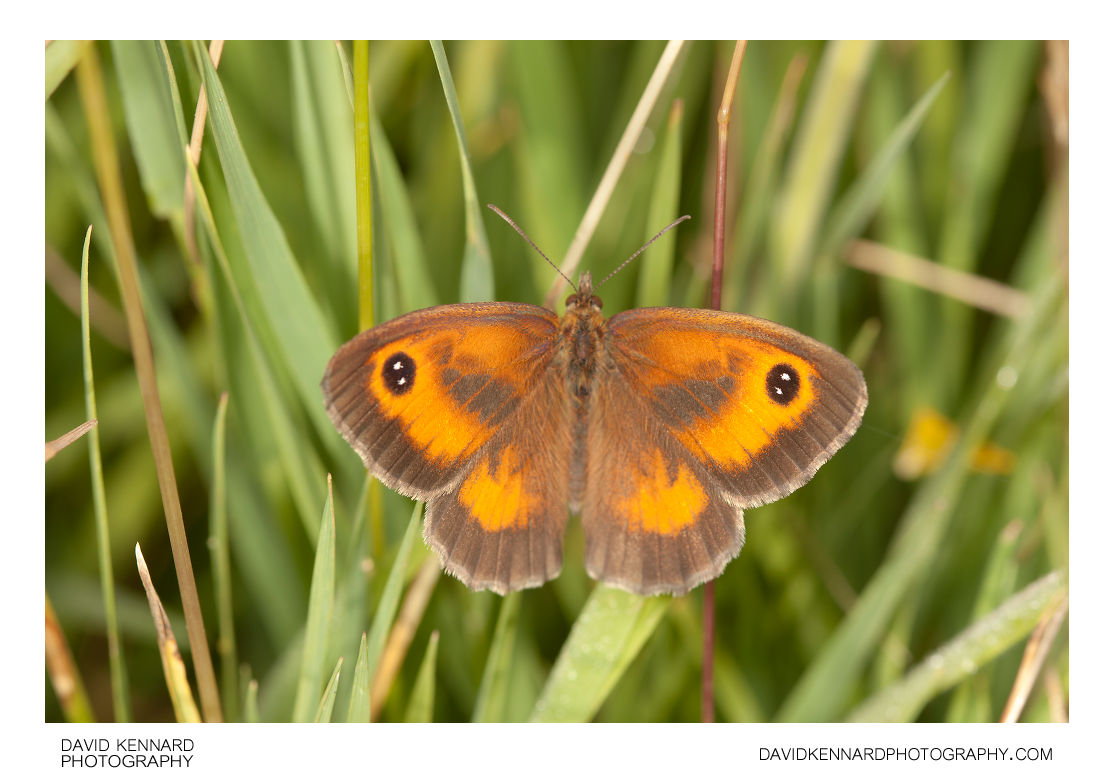Gatekeeper (Pyronia tithonus) butterfly

Description
- Title:
- Gatekeeper (Pyronia tithonus) butterfly
- Caption / Description:
-
The Gatekeeper (Pyronia tithonus) sometimes called the Hedge Brown is a common butterfly in the United Kingdom. It is a member of the subfamily Satyrinae in the family Nymphalidae. A similar species is the Meadow Brown, especially in the female sex, which likes to rest with closed wings however, especially the far less active females.
The name "Gatekeeper" may refer to its frequent occurrence near field gates and to the man who was responsible for the toll gates in the eighteenth and nineteenth centuries when butterflies were more numerous than they are today. As indicated by its alternate name, the gatekeeper butterfly prefers the habitat of meadow margins and hedges; field gates are often in such locations, and thus the Gatekeeper can be found much more frequently in such locations than the Meadow Brown for example.
The larvae of Satyrinae all feed on grasses, such as Rough Meadowgrass Poa trivialis, Smooth Meadow Grass Poa pratensis, Sheep's Fescue, and are usually green or brown in colour. The pupae are a flimsy chrysalis either hanging upside down or lying in grass. The adults are often found round blackberry plants. The adult butterflies have a quite short proboscis and the flowers of the blackberry being quite shallow provide an excellent nectar source. Males have a dark patch of scent scales in the middle of the forewing for courtship purposes except in very old individuals. This dark patch is clearly visible in the male Gatekeeper. The characteristic eyespots on the forewing probably deflect bird attacks away from the butterfly's body rather than startle away predators; the Gatekeeper likes to rest with its wings open and the eyespots visible. It flies more but strays about less than the male Meadow Brown (Stevens 2005).
Description from Wikipedia: http://en.wikipedia.org/wiki/Gatekeeper_Butterfly
- Tags / Keywords:
-
- Biota
- Life
- Vitae
- Eukaryota
- Animalia
- Animals
- Arthropoda
- Arthropods
- Insecta
- Insects
- Lepidoptera
- Butterflies
- Nymphalidae
- Brush-footed butterflies
- Four-footed butterflies
- Pyronia
- Pyronia tithonus
- Gatekeeper
- Hedge Brown
Admin
- Date Original Photo Taken:
- Original File Name:
- _MG_2725.CR2
- Event:
- Rating:
- Date this image added/last updated on website:
- Original File Dimensions:
- 4272px x 2848px
- File Type:
- JPEG
- Color Mode:
- RGB
- Original Image Color Profile:
- Adobe RGB (1998)
Location
- Location Created:
-
- Sublocation:
- City:
- Market Harborough
- Province/State:
- Leicestershire
- Country:
- United Kingdom
- World Region:
- Europe
- Geo-location:
Rights
- Copyright Status:
- Copyrighted
- Licensing Status:
- Rights Managed
- Available for Editorial Use:
- Yes
- Available for Commercial Use:
- Yes
- Copyright Notice:
- © 2010 Dave Kennard
Camera Data
- Date Digital Resource was created:
- Shutter speed:
- 1⁄200 s
- Aperture:
- f/6.3
- Camera Model:
- Canon EOS 450D
- ISO:
- 100
- Exposure Compensation:
- 0
- Focal Length:
- 100mm
- Focal Length (35mm equiv.):
- Metering Mode:
- Multi-segment
- Flash:
- On, Fired
- Exposure Mode:
- Manual
- White Balance:
- Manual
- Light Source:
- Exposure Program:
- Manual
Additional shooting metadata
- Lens:
- Canon EF 100mm F2.8 Macro USM
- Filters used:
- Additional Optics used:
- Setup:
- Handheld
Canon MT-24EX Macro Twin Flash with home-made concave diffusers
Post Processing
- Image Modified:
- Software used:
-
- Adobe Camera RAW
- Post Processing:
-0.4 exposure in ACR
